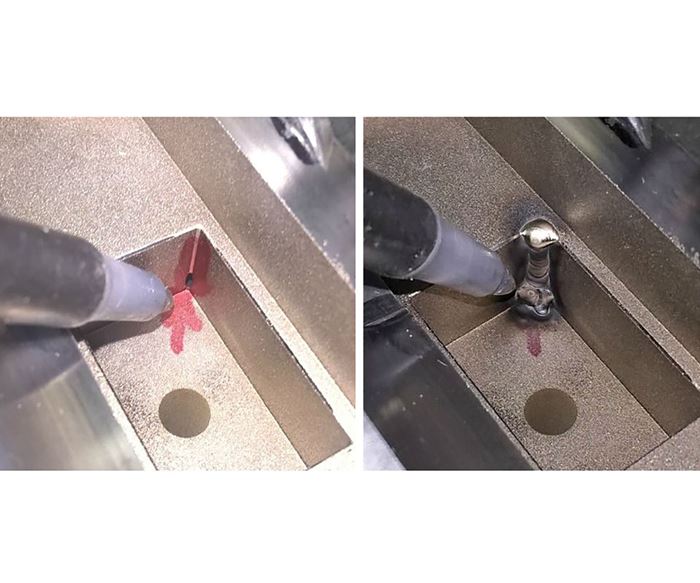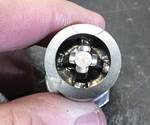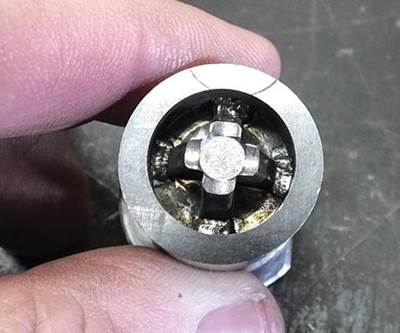Under the Scope: A Case for Micro-TIG Welding
Laser welding’s low heat output makes it the only viable choice for certain welding repairs, but it is not appropriate for all repairs. Micro-TIG offers its own set of benefits.
Laser welding’s low heat output makes it the only viable choice for certain welding repairs. It has even superseded micro-TIG welding in many ways. However, the question remains: “Can micro-TIG welding be completely replaced by laser welding?” The answer is no, and here are some reasons why:
Penetration and durability. Sometimes customers complain that laser welding does not penetrate as deep or adhere as well as micro-TIG welding. Adjusting the pulse width, power density and filler choices can help resolve these two challenges, however.
In my experience, the welding arc created in the micro-TIG process digs deeper into the base material, which is essential for filling holes and large damaged areas. Figure 1 shows an EDM pocket with a hole running along the corner that broke into a water line. In an instance like this, micro-TIG welding can melt deeper, which allows more weld to fill up the damage in the water-line hole.
Degree of damage and weld size. I use laser welding for small repairs such as weld buildups of 0.005 to 0.010 inch on molds and inserts. This is because the heat output of a micro-TIG process could cause damage. Laser welding is capable of handling much larger buildups, but in my opinion, that is an impractical use of the technology. In many repair situations, laser welding requires a longer weld time than micro-TIG welding because the welder is simply not adding the same amount of filler rod.
Laser welding also often needs a “smoothing” pass when the welding is done in multiple passes. To complete a smoothing procedure, the welder welds over a previously laser-welded area without adding rod to break any porosity. Each laser weld layer needs a smoothing pass before adding more rod. Unfortunately, this time-consuming procedure makes laser welding of large buildups an unreasonable application. Figure 2 shows a typical large micro-TIG-welding die repair. Micro-TIG welding is the faster and more efficient process to repair damage of this size.
Block size and ease of access. All laser welding must be done in a series of steps in order to be effective: Position the correct optical distance and laser pulse displacement, align the correct angle of the laser arm to reach optimum penetration, and correctly position the shielding gas.
Block size and position of the block for the laser arm should also be considered. This is where size can pose a challenge. Although laser arms allow some movement, it is not the same as that of a human wrist guided by a TIG-welding torch. Micro-TIG welding’s freedom of hand mobility allows the welder to access certain areas more efficiently and faster than he can with laser welding.
For example, there are times when I have spent 20 minutes lining up my laser on a large block and then have only welded for a few moments before needing to change position. If the repair is in a critical area, the additional time is probably worth it, but many times you can micro-TIG weld the block much faster and achieve the same result.
Contaminants. Anything that will be laser-welded must be critically clean. Any rough areas that are not removed prior to laser welding will cause problems. Micro-TIG welding creates a larger weld puddle, which can burn down problem areas. This gives the micro-TIG machine a distinct advantage over a laser welder in welding over contaminants and impediments such as rough steel, burrs and sharp areas.
Complementary processes. Another consideration is using the strengths of both processes on a repair in different steps. For example, look closely at the micro-TIG-welded piece in Figure 3 and notice the sink around the welded area. For this job, I laser welded the seam line around the area (where the micro-TIG weld meets the original steel) to fix any problems. My shop frequently uses this procedure to capitalize on the strength of micro-TIG welding and create larger and faster buildups, and uses a laser welder to fix the sink.
I use laser welding for at least 50 percent of my welding repairs, but laser welding is not appropriate for all repairs. Before selecting your method of choice, consider the advantages and disadvantages of both processes. Even if you brought mold repair in-house with a laser welding setup, it is important to keep in contact with a professional micro-TIG service, because eventually you will run into repairs that are more suited for micro-TIG welding.
Related Content
Considerations for Mold Base Material Selection
Choosing the right material can greatly affect the profitability and cost of your application.
Read MoreMaking Quick and Easy Kaizen Work for Your Shop
Within each person is unlimited creative potential to improve shop operations.
Read MoreMold Design Review: The Complete Checklist
Gerardo (Jerry) Miranda III, former global tooling manager for Oakley sunglasses, reshares his complete mold design checklist, an essential part of the product time and cost-to-market process.
Read MoreMaintaining a Wire EDM Machine
To achieve the ultimate capability and level of productivity from your wire EDM on a consistent, repeatable and reliable basis, regular maintenance is a required task.
Read MoreRead Next
Under the Scope: Considerations for Mold Repair Welding
This new series is intended to arm toolmakers and engineers with the necessary knowledge to make better informed decisions during tool repairs, including an understanding of welding terminology, procedures and challenges.
Read MoreReasons to Use Fiber Lasers for Mold Cleaning
Fiber lasers offer a simplicity, speed, control and portability, minimizing mold cleaning risks.
Read MoreAre You a Moldmaker Considering 3D Printing? Consider the 3D Printing Workshop at NPE2024
Presentations will cover 3D printing for mold tooling, material innovation, product development, bridge production and full-scale, high-volume additive manufacturing.
Read More
















.jpg;maxWidth=300;quality=90)











